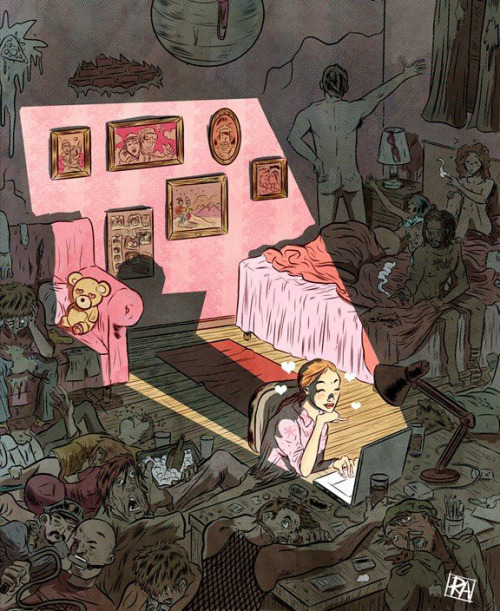
via Tumblr
a strange multi media collection, including some cats, personal stuff, geek paraphernalia =======================> some cool videos and a grand majority of old memes.

A design contract is like a business card—it comes from the same desk, and bears the same creative mark. But it’s also the business card you hate handing out: a folder of legal gibberish with terrible formatting that reminds the client of everything that could possibly go wrong before the work has even started.
Is this just a necessary evil? Why can’t contracts evolve like everything else?
Actually, they can—and should. Modernizing your contract will not only make it match your carefully crafted brand, but it can also help you reach an agreement faster, and even strengthen your position when negotiating. This is not an easy task. Legal content is a delicate matter, and you definitely can’t start tweaking your contract like it’s a blog post.
Before we start modernizing contracts, we first have to understand their purpose, and how and why they got the way they are. It’s a long journey back.
The Romans developed a sophisticated system of commercial law that has become the foundation for pretty much all of the Western world’s legal systems. A design contract was probably signed to make the incredible decorations of Ara Pacis. Such a contract would have been created to accomplish something not that different from today’s products of design: defining what must be done, the deadline, the client’s approval, and the price. The concept of copyright did not exist yet, but unauthorized and fraudulent copies of literary works were socially unacceptable. (As for non-literary works, good luck copying those marble statues.)
While our work has evolved, contracts have essentially stayed the same—for a number of good reasons. In fact, several principles are just as important in today’s contracts as they were in Roman times.
Spoken words fly away, written words stay.
In a world where few people could read or write, a written contract was much more difficult to obtain—and therefore much more valuable than a handshake. Romans were the first to establish a now-universal principle of civil procedure: The burden of proof is on the plaintiff (onus probandi incumbit ei qui dicit). Therefore, a written contract protects the wronged party. This is still true today, so don’t only use a written contract before work begins; make sure every modification is documented in writing.
That’s a much easier task today than in Roman times. You don’t have to run to a scribe, or even a notary. E-mail has been proved legally binding multiple times, so to amend a contract, you can just drop a line like, “As discussed in today’s meeting, we mutually agree to modify the statement of work as follows…”
Some contracts even have a clause that requires all amendments to be in writing. If that’s the case, you’ll want to make certain you follow it; otherwise, the client can make excuses for not paying you for extra work.
AIGA’s standard agreement for design services uses a nifty solution to make sure all modifications are in writing and that there’s a limit to the number of modifications that can be requested:
4.2 Substantive Changes. If Client requests or instructs Changes that amount to a revision of at least 15% of the time required to produce the Deliverables, and or the value or scope of the Services, Designer shall be entitled to submit a new and separate Proposal to Client for written approval. Work shall not begin on the revised services until a fully signed revised Proposal and, if required, any additional retainer fees are received by Designer.
As you can see, it’s the same old verba volant, scripta manent still in use.
Give something, keep something.
The value of a project depends not only on what you put in a contract, but also what you leave out. This is particularly true for design, which is not strictly a product, nor strictly a service. It’s a hybrid set of “deliverables,” and the contract (not the e-mail with the design attached) is the place where you give them to your client.
Be wary of what you give and keep. If possible, hold onto copyright: Delay the assignment, or the effective date of the license, until the money is in the bank. This is the best leverage you have.
Clients will try to do the same with payment, of course. Welcome to contract negotiation.
On this inevitable battlefield, details make a difference. For example, imagine you are an illustrator who creates a set of characters for a story. Your client picks the ones they like, and those are the deliverables they buy. Why shouldn’t you keep the rest, and “recycle” them for future projects? If you don’t specify this in the contract, the client will be assigned all the work in connection with the project, including unused sketches.
Same thing if you are delivering code. It’s common to incorporate snippets of code into multiple projects, but just because that code ends up in that project doesn’t mean that client owns it. These are usually called “design tools” in a contract—which means instead of giving something away, you’re simply giving your client permission to continue using the tools.
Laws are useless without customs.
Just as graphical and technical standards are essential to designing, standards and industry practices play a crucial role in negotiating contracts. Following best practices not only lowers transaction costs and streamlines the process, but also fosters more balanced deals.
What are the contractual standards of design? The AIGA agreement mentioned earlier is a great start, but standards can also live in single clauses. Eric Adler, a lawyer who works with creative professionals, knows which clauses of his contract are more likely to be negotiated, and takes care to explain those to his clients.

An excerpt from Eric Adler’s contract annnotations.
When it comes to liability, Adler suggests that it’s standard to cover your asse(t)s up to the overall net value of the project. You could try to ask for more, but no one wants to make a client nervous over a legal boilerplate, and standards make sure this doesn’t happen.
Standards don’t just come from lawyers or unions. Andy Clarke’s Contract Killer is extremely popular among freelance designers—in fact, a version of his contract is one of the most viewed and downloaded items at my company, Docracy, which provides an open collection of legal documents. This is likely due to Clarke’s strict no-legalese policy. He even dropped the classic impersonal language, transforming it into a natural dialogue with the client: “What both parties agree to do.”
The result is a set of informal yet clear rules that cover essential legal provisions, like assigning copyright only upon full payment and reserving portfolio rights.
But where is all the horrible small print?
There is none. This contract shows that it’s possible to enter a binding agreement using everyday English. Your lawyer may not like it, because he may fear not being taken seriously enough, or feel uneasy not following his standard. Fortunately, this is something that has actually changed since the Romans. They had to use formulae and magic words to make sure the contract would be upheld in court, while we typically enjoy shared language and literacy skills.
Unusual clauses will raise flags.
We all like standards, but let’s face it: Everything is negotiable, and people will always try to sneak advantageous clauses into the contract. You need to make sure you don’t sign anything you’ll regret, and spotting bad provisions is not a lawyers-only job. Scanning contracts is a necessity sometimes, so always look closely at the following parts:
The more contracts you read, the better you’ll get at spotting weird provisions. Trust your judgement: If something doesn’t seem quite right, it probably isn’t.
At minimum, you should ask for an explanation. This is never a waste of time. If you have a lawyer do this, just find someone who doesn’t bill by the hour, or this negotiation will take forever.
A deal is a deal.
Both in Roman times and today, if you don’t deliver, it’s on you. Keeping promises is fundamental for a professional reputation. That’s why you have to be clear and consistent in the promises you make.
How do inconsistencies arise? One common way is having a statement of work (SOW) that’s not compatible with a master service agreement (MSA). This happens more often than you might think, particularly if no one has ever read that thirty-page agreement. If it’s not clear which one prevails (yes, you have to write it down), you can find yourself in a legal mess.
For example, capping your hours in the MSA is a great way to mitigate the fixed-fee or milestone-based pricing you agreed to in the SOW, but only if the cap prevails! Vice-versa, if you know you’ll only be looking at the SOW and all the special payment provisions are in there, then it should probably override any older pricing rule buried in that thirty pages of small print.
Even better, an MSA doesn’t really need to include thirty nasty pages of small print.
I bet you didn’t read iTunes’ latest Terms and Conditions before clicking “I Agree.” We try to read contracts when we think it’s important, but it’s not easy, for several reasons:
The good news is, these problems can be fixed.
Let’s start with font. Designers and clients alike now mostly read on screens. Electronic signing is a reality, so there are few arguments for optimizing a contract for print.
If you’ve studied typography, you know how to use contrast, proximity, and alignment to create emotional and persuasive effects, and you can apply these same principles to legal text.
Matthew Butterick, author of Typography for Lawyers , has even developed a font optimized for legal text: Equity, a serif font that also looks good on screen—a nice compromise. Whatever you choose, ensure you give your contract balance and contrast.
Contracts are a very peculiar subset of legal documents. How can you use typesetting skills to improve their layout?
You’ll also need to decide whether to justify or left-align text. The general rule is that justified text only works with proper hyphenation. This means you’ll have to manually input non-hyphenated breaks for the words you want to keep on the same line. Unless you’re drafting the contract yourself from start to finish, this is a daunting task. And, if your contract manages to have short paragraphs, ragged-right looks more natural, particularly on screen.
When we redesigned Docracy’s PDF typography, we opted for a longer line with lots of white space on the sides. This lets even the longest contract breathe, yet creates a compact final look:

Now for the million-dollar question: Why are contracts written in legal jargon? Sadly, it’s because lawyers are too lazy and change-averse to rewrite their forms. The good news is, this is changing. And you can contribute; most formulaic “legalese,” like herein, thereof, or hereby, can just be replaced with “this.” You might even be able to remove entire lines, but better check with a lawyer to make sure.
Here’s an example of traditional contract language rewritten in plain English. Not only is the new version half the length, but it’s much easier to understand:
Before | After |
|---|---|
Timing. Designer will prioritize performance of the Services as may be necessary or as identified in the Proposal, and will undertake commercially reasonable efforts to perform the Services within the time(s) identified in the Proposal. Client agrees to review Deliverables within the time identified for such reviews and to promptly either, (i) approve the Deliverables in writing or (ii) provide written comments and/or corrections sufficient to identify the Client’s concerns, objections or corrections to Designer. The Designer shall be entitled to request written clarification of any concern, objection or correction. Client acknowledges and agrees that Designer’s ability to meet any and all schedules is entirely dependent upon Client’s prompt performance of its obligations to provide materials and written approvals and/or instructions pursuant to the Proposal and that any delays in Client’s performance or Changes in the Services or Deliverables requested by Client may delay delivery of the Deliverables. Any such delay caused by Client shall not constitute a breach of any term, condition or Designer’s obligations under this Agreement. | Timing. Designer will prioritize the Services as may be necessary, or as identified in the Proposal, and will take reasonable efforts to perform the Services in a timely manner. Client agrees to review Deliverables within the time identified in Schedule A and to either (i) approve the Deliverables in writing or (ii) provide exhaustive written feedback. Designer may request written clarification of any of Client’s comments. Delays in the performance of the Services due to Client’s late feedback or requested Changes will not constitute a breach of Designer’s obligations. |
There are many reasons the core rules of contracts are still in place two millennia after the fall of Rome. But there are other elements that we can, and should, take to the twenty-first century.
If we want to address the readability problems unique to our era—and improve communication with our clients—then it’s time we fix the language, layout, and typesetting of our contracts. And who better than designers to do it?

love the new google images


como le hacen fama, si al final un santito es …

from nevver


una mas, una caladita mas …

I told you, but you never listen ….

from fueltherebellion

 Dear Lifehacker,
Dear Lifehacker,
Over the years I've collected hundreds of books I want to read, but no matter what I do they just keep piling up. Is there a way I can read faster and get through this backlog quickly?
Sincerely,
Buried Under Bradbury
Dear BUB,
We certainly understand your pain. It's easy to get buried under a bunch of books you purchased (or just find yourself with an Amazon wish list of 200 titles). Thankfully, getting caught up on all those books isn't always as hard as you might think. Here are a few different ideas for getting through you backlog.
 Speed reading is all about reading as fast as you can, and it's a suprisingly easy technique to learn. You can teach yourself speed reading with a webapp like Spreeder, but speed reading is based on a few key techniques that anyone can pick up:
Speed reading is all about reading as fast as you can, and it's a suprisingly easy technique to learn. You can teach yourself speed reading with a webapp like Spreeder, but speed reading is based on a few key techniques that anyone can pick up:
Speed reading isn't for everyone, and while some people can certainly retain a lot of the information they read, many people can't. So, if you're interested, give speed reading a try, but don't feel like you have to commit to it just to get through all your books. You have other options.
 Another trick often associated with speed reading is skimming the text. As former British Prime Minister Arthur James Balfour once said, "He has only half learned the art of reading who has not added to it the more refined art of skipping and skimming."
Another trick often associated with speed reading is skimming the text. As former British Prime Minister Arthur James Balfour once said, "He has only half learned the art of reading who has not added to it the more refined art of skipping and skimming."
Skimming is one of method of speed reading, and while it's not great for comprehension (don't do this in your college textbooks), it's a good way to quickly get through your backlog of books. This works especially well for non-fiction when you might not be interested in certain parts of a book. Professor David Davis shares his strategy for effective skimming:
Obviously you don't want to do this for every single book you're trying to get through, but it's an effective strategy for topics you're mildly interested in. Of course, if a few chapters sound more interesting than others, you can pop in and read just those ones. Skimming works especially well for history books, essay collections, memoirs, or current interest books. Photo by Arria Belli .
 Chances are that you can't read all the time. After all, you have to drive places, cook meals, and exercise. For those times when you can't have a book in your hand (or it'd be dangerous to do so), audiobooks are a great way to fill the silence and catch up on your backlog.
Chances are that you can't read all the time. After all, you have to drive places, cook meals, and exercise. For those times when you can't have a book in your hand (or it'd be dangerous to do so), audiobooks are a great way to fill the silence and catch up on your backlog.
Most major book sellers like Amazon, iTunes, and Barnes and Noble all sell audiobooks. Also, Audible allows you to buy audiobooks, and also offers a subscription service that gives you one book a month for $14.95 (a considerable savings since audiobooks tend to sell for $30-$40).
If you're a little wary of audiobooks, you don't actually have to pay to try them out. You can find free books on Audible with a Google search, and grabbing one free book on Audible is usually pretty easy provided you're willing to try the service free for 30 days. Sites like Books Should Be Free and Open Culture also offer free audiobooks.
 Last year, Jeff Ryan set a New Year's resolution that he'd read 366 books in a year. That seems like a hefty goal, but, writing for Slate, Ryan explains how he did it:
Last year, Jeff Ryan set a New Year's resolution that he'd read 366 books in a year. That seems like a hefty goal, but, writing for Slate, Ryan explains how he did it:
The idea of a full book a day—going from title page to back-jacket blurbs—went quickly out the window. I read lots of books at once, and can go days making progress in five or six volumes without technically finishing any of them. Then there are flat-out busy days, where the actual drop-dead demands of my job and parenting mean there is not a second to spare for reading. My worst lull was during a Florida trip, when I barely plowed through the 300 pages of John Irving's The Fourth Hand . And that was during a whole week of family vacation-the time when normal people read more. It took a month of catchup to get back at pace.
Of course, he combined that with a few other tactics, including listening to audiobooks, as well as comics and graphic novels. Still, his tactic of reading multiple books at once is one way to get through your backlog provided you can differentiate between all of them. In this case, it's likely best to stick to different genres so you don't confuse yourself too much. Photo by J Brew .
 This seems like common sense, but it's still worth noting: if you're a couple chapters into a book and you're not enjoying it, stop reading it. Once you stop, think about why you're not enjoying it. Is it just the wrong book at the wrong time? Then put it back in your backlog and wait for the right time. Is it a book someone recommended and you're not enjoying it? Then return it to the seller, pass it along to someone else, or donate it to a library. You're not going to enjoy every book, so don't waste time on books you don't like.
This seems like common sense, but it's still worth noting: if you're a couple chapters into a book and you're not enjoying it, stop reading it. Once you stop, think about why you're not enjoying it. Is it just the wrong book at the wrong time? Then put it back in your backlog and wait for the right time. Is it a book someone recommended and you're not enjoying it? Then return it to the seller, pass it along to someone else, or donate it to a library. You're not going to enjoy every book, so don't waste time on books you don't like.
Depending on just how tall your backlog of books is, getting through them shouldn't take too much time. Set up a schedule to help you fit reading into your day, and start cranking through all those books. Photo by mikael altemark .
Good luck,
Lifehacker
Have a question or suggestion for Ask Lifehacker? Send it to tips+asklh@lifehacker.com.
Title image remixed from silver-john (Shutterstock) and gladcov (Shutterstock).
2012 was a big year for Photoshop. In April, Adobe released Photoshop CS6 and launched the Creative Cloud, and more recently announced the Photoshop 13.1 update. During that time, our authors produced some amazing Photoshop conent. In this article, we wanted to take a look at some of our favorite Psdtuts+ tutorials from 2012. Let”s take a look!
Editor”s note: This articles includes both standard and premium content.

Making modifications to your car or truck in Photoshop can be a lot of fun. In this tutorial we will demonstrate how to create a pimped out truck modification using photos taken with a simple point and shoot camera, with no advanced lighting setup.

Photoshop is great at seamlessly combing photos to create an entirely new scene. In this tutorial we will create an elephant sundae using several stock photos.

Photoshop is a fantastic tool to help 3D artists save time and improve the look of their renders. In this tutorial we will demonstrate how to combine ZBrush materials and lighting render passes to create a stunning metallic textured skull.

When most people think about Photoshop, they probably don”t think about 3D. What most people don”t realize, however, is that Photoshop Extended includes some powerful tools to help you render your artwork in 3D. In this tutorial we will demonstrate how to create a mini planet using Photoshop”s 3D capabilities.

Photoshop actions are excellent tools for speeding up your workflow. In this tutorial, Diego Sanchez will use Photoshop actions to create a cocktail blueprint from scratch.

In this tutorial we will demonstrate how to take pieces from multiple photos and seamlessly blend them into a "coffee cake" photo manipulation. This tutorial will also explore unique ways to work with paths and smart objects.

In this tutorial, we will explain how to integrate a rendered 3D model into a photograph to create a macro photography effect.

In this tutorial we will create a clean Twitter app interface in Photoshop using layer styles and basic vector shapes.

Applying texture to a text effect can be a lot of fun. In this tutorial we will explain how to create a baseball-inspired text effect using layer styles, patterns, and brushes.

In this tutorial we will explain how to create a one-page retro web design using Adobe Photoshop. While most of the design is created in Photoshop, we will also use Illustrator to create various shapes and elements.

Taking your own photos and combining them into an entirely new composition can be quite satisfying. In this tutorial, Josh Dykgraaf will show you how to create a walking city using a combination of photos that were taken exclusively for this project, as well as a few stock photos.

In this quick tutorial we will show you how to create a royal gold text effect using layer styles in Photoshop.

Photoshop CS6 is packed with new features and effects that you can use in your work. In this tutorial we will utilize Photoshop”s new 3D capabilities as well as its new content aware features to create a Micro Machines inspired composition.

Disney”s "Tron Legacy" featured some stunning special effects. In this tutorial, Sheridan Johns will explain how to achieve similar results using digital painting, composition, and lighting effect techniques.

Layer styles are a powerful and time saving feature that can help you apply amazing effects to your designs. In this tutorial we will use layer styles to create a light bulb inspired text effect in Photoshop.

Photoshop CS6 is packed with new features that will help you create better interface designs. In this tutorial we will utilize Photoshop”s new vector editing and stroke capabilities to create an administrator dashboard interface. We will also take advantage of Photoshop”s new snap to pixel grid feature to help create crisp and clean web graphics.

Photoshop is a great tool because it allows us to be creative and produce imagery that would be impossible to create otherwise. In this tutorial, Tony Aubé will create a snowy landscape from desert photography and photos of sand.

In this quick tip tutorial we will explain how to create a steel text effect using layer styles in Photoshop.

While thinking up a strong concept is often one of the biggest challenges that a designer will face during the creative process, executing that concept can be equally, if not more challenging. In this tutorial, Liran Szeiman will explain how to create a cute, but dark, fantasy illustration in Photoshop using digital painting techniques.

Selections are an essential part of any photo editing workflow, but often, selections aren”t as straight-forward as they might seem. In this tutorial we will explain how to make a selection of a glass that includes transparent elements.

In this tutorial we will explain how to create an amplifier interface using simple shapes and layer styles.

If you”ve got a sweet tooth, then we”ve got a mouth-watering tutorial for you. In this tutorial, Mark Mayers will show you how Photoshop CS6 Extended”s new 3D tools can be utilized to create a typographic illustration that includes lots of sugary treats.

In this tutorial we will explain how to create a metallic copper text effect using layer styles in Photoshop.

Leica is considered one of the most prestigious camera brands. In this tutorial, we will draw one of the most notable Leica cameras in Photoshop, the Leica M1.

In this quick tip tutorial we will explain how to create a cookie text effect using layer styles and textures in Photoshop.

Photoshop CS6 includes several new features that you can use to create 3D and video effects. In this tutorial, Stephen Petrany will combine these new tools to simulate 3D depth in a 2D photograph using the new 3D and video timeline features available in Photoshop CS6 Extended.

If you”re a big fan of playing video games, then you are probably aware of the release of Diablo III. The Diablo franchise has been a popular video game title for over a decade. In this tutorial, we will explain how to create a Diablo-inspired text effect in Photoshop.

In this tutorial, Sheridan Johns we will explain how to create stunning "Iron Man" fan art in Photoshop using digital painting techniques. This tutorial will begin as a sketch and then show how to slowly build up your artwork to create realistic metallic objects. We will then incorporate some photographic elements such as smoke and sparks to enhance the overall realism of the piece.

In this quick tip tutorial we will explain how to create a plastic switch in Photoshop that you can use in your interface designs.

This tutorial by Liran Szeiman is an interpretation of the song "Everything Dies" by Type O Negative and will explain how to create a dark and emotional digital painting in Photoshop.
In this tutorial we will create the Evil Queen from Snow White and the Seven Dwarves using digital painting techniques in Photoshop.

In this quick tip tutorial we will show you how to create a glass text effect using layer styles in Photoshop.

Actions are a powerful tool in Photoshop. They can be used to automate all sorts of tasks. In this tutorial we will explain how to use actions to create a 3D soda can.

Photoshop CS6 is packed with new and powerful features. In this tutorial, Stephen Petrany will explore some of Photoshop CS6 Extended”s enhanced 3D features by showing how to create a realistic 3D hood ornament.

By combining certain fonts and styles, you can create graphics reminiscent of the automobile emblems of the 1950′s, also known as Brightwork. In this tutorial we will show you how to create a reflective, retro chrome emblem using Photoshop layer styles and a few selection tricks.

In this quick tutorial we will show you how to create sports-themed text effect using layer styles in Photoshop.

In this quick tip tutorial we will explain how to create a candy cane-style text effect in Photoshop.

Photo composites often require several Photoshop tools and techniques to achieve a desired effect. In this tutorial by author Mario Sánchez Nevado, we will combine several photos to create a statue from a photo of a model. We will then explain how modify the statue to create cracks, and molten rock using layer masks, adjustments, and several blending and painting techniques.

Creating a horror movie-themed photo composition in Photoshop can be a lot of fun. Choosing the right photos is an important step in the process, but it is also important to blend those photos together in a realistic and believable way. In this tutorial we will show you how to do this using the appropriate light balance, use of midtones, depth of field, blending, and more.

Among the most challenging and potentially useful skills an artist can have is the ability to design entirely new characters, environments and vehicles. Master these skills, and the doors open not only to your own creative expression, but to potential employment in the video game, film and publishing industries. In this tutorial, Alex Ries, we will walk through the design and painting of an extra terrestrial seaplane in Photoshop. This requires research into the familiar elements of real-world aircraft, and combining those elements into an original form that looks functional and familiar, yet clearly non-human.

In this tutorial, we will explain how to create a cute and scary children”s illustration in Photoshop.

Photoshop has become a multi-purpose tool that can create some complex animations without the need to purchase additional software. In this tutorial, we will show you how to create and composite a 3D animation with sound and lighting effects. We will also cover techniques on how to optimize your rendering time.

In this quick tip tutorial, we will explain how to create a crisp, metallic text effect using just a couple of layer styles in Photoshop.

Creating a nice character painting in Photoshop can be a difficult but rewarding task. In this tutorial, we will explain how to create a classic Batman villain in Photoshop.

In this tutorial, Alex Ries will show you how to create a near-future space fighter without referencing these earlier science fiction designs. Instead, he will show you how to create a more realistic concept referencing the real world.

Attempting to replicate real life objects in Photoshop is great practice. In this tutorial we will explain how to create a realistic, retro Gameboy device using Photoshop”s powerful feature set.

In this tutorial, we will explain how to combine Photoshop filters, brushes, and vector shapes to create a stitched denim text effect using Photoshop CS6.

Sometimes all you need to create a stunning piece of Photoshop art is a camera, some Photoshop know how, and some creativity. In this tutorial, Joshua Dykgraaf will explain how to create a robotic motorcycle god using photos taken of motorcycle parts.

Robots are a staple of the science fiction media landscape. Concept artists working in this field, whether it be through video games, publishing, or film are well served with a number of robotic designs in their portfolios. In this tutorial, Alex Ries will explain how to illustrate a near-future combat robot in Photoshop.

In this tutorial, we will explain how to create a furry cartoon character in Photoshop.

Photoshop plugins are great tools to help you save time and improve the quality of your work. In this tutorial, we will use Filter Forge to help create a knitted argyle text effect in Photoshop that you can use in your holiday illustrations.

Designers often use several apps to create their work. What is great about Adobe products is that you can easily switch between them to perform various tasks. In this tutorial, we will show you how to design a magazine layout using Adobe InDesign. We will then show you how to create a realistic and reusable magazine mockup of that design in Photoshop that you can present to your clients.

Adobe Photoshop CS6 Extended is packed with an all-new 3D interface and tons of new features. In this tutorial, we will explain how to use those new features to create an autumn-themed 3D text effect.

Liu Kang is one of the most iconic characters from the world of Mortal Kombat. In this tutorial, George Patsouras will discuss how to paint a Bruce Lee-inspired Liu Kang in Photoshop. Since this will deal with portrait painting, you can use these techniques to recreate the Liu Kang painting, or you can come up with something entirely on your own.

In this tutorial, Stephen Petrany will explain how to build a holiday gingerbread cookie illustration using copies of a single Smart Object. This technique will allow us to quickly update the shape of our cookie with very little effort in order to make multiple cookies for a more complex final scene.
You might also want to take a look at some of the excellent series that we published in 2012.

In this series, Martin Perhiniak will explain some time-saving tips to help you work more efficiently with Adobe Photoshop.

Photoshop layer styles are a popular way to add effects, such as drop shadows and strokes, to layers in a non-destructive way. In this Session, we”ll show you how to unlock their potential!

Photoshop CS6 has finally arrived. It has come packed with new features and tweaks that will significantly improve your workflow and enhance your tool set. In this series we will take a look at some of Photoshop CS6″s new features and show you how they work.